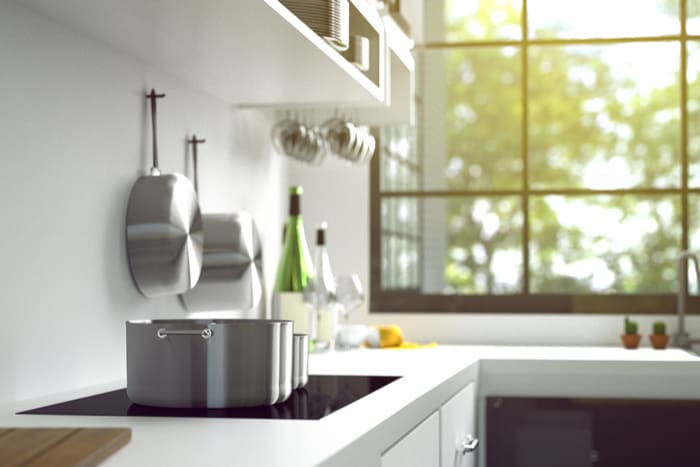Teflon vs. Copper: Which Cookware Should You Choose?

What does your dream kitchen look like? Maybe it’s classic and cozy, with a large wood- burning oven. Maybe it’s bright and cheery, with lots of flowers and school pictures on the refrigerator. Or maybe it’s an open-concept, with hanging racks for your pots and pans. Oh, and about those pots and pans—in this fantasy, are you using copper or Teflon? There are pros and cons to each of them. Read on, and get one step closer to making your dream kitchen a reality.
Copper Cookware
Is copper right for your cooking needs? Let’s weigh the pros and cons.
Benefits of Cooking in Copper Pots and Pans
1. Copper is good enough for the pros.
That’s right. Most professional chefs love copper because it cooks evenly and precisely.
2. It’s beautiful.
Remember that dream kitchen with the hanging racks for pots and pans? Copper cookware would look right at home there. Copper is shiny and rich, making it an attractive option.
3. It’s lightweight.
Copper is high in quality but low in weight. Think of it like a lightweight jacket that keeps you warm—it does more with less.
Drawbacks of Cooking in Copper Pots and Pans
1. It wears out quickly.
Since copper is so reactive, it can actually wind up having a shorter lifespan than its Teflon counterparts.
2. Copper is expensive!
You’ll pay more for a product that may not last as long.
3. It’s not dishwasher-safe.
That’s right. You’ll wash and dry your copper cookware by hand every time.
Teflon Cookware
Teflon cookware is made up of synthetic non-stick materials. Is it right for your kitchen?
Benefits of Cooking in Teflon Pots and Pans
1. Teflon is non-stick cookware at its finest.
Using Teflon pots and pans can make cooking easier from beginning to end. You don’t need to use oils or cooking sprays to coat it, and you don’t have to do much to clean it. A win-win!
2. It’s scratch-resistant.
Teflon doesn’t scratch, so you can use it for years to come
3. It distributes heat evenly.
Like copper, Teflon pots and pans boast an equal distribution of heat, so you can rest assured that all your dishes will wind up cooked evenly.
Drawbacks of Cooking in Teflon Pots and Pans
1. It’s not as attractive.
There’s nothing like the opulent vibes of gleaming copper pots and pans. While effective, Teflon doesn’t have quite the same curb appeal.
2. Teflon poses some significant safety hazards.
While generally safe to use, Teflon comes with a caveat: Its non-stick coating can release certain carcinogens if it reaches a high temperature. This happens above 500 degrees Fahrenheit, which is the generally accepted highest temperature for cooking with Teflon.
Sources:
Bold, Cambria. (2012, March 27.) A Guide to the Best Material for Pots and Pans: A Pros and Cons List.
https://www.thekitchn.com/a-guide-to-the-best-material-for-pots-and-pans-pros-cons- 168241
Rediff.com. (2015, April 30.) 5 Reasons Why You Should Switch to Non-Stick Cookware Today.
http://www.rediff.com/travel-living/report/5-reasons-why-you-should-switch-to-non- stick-cookware-today/20150430.htm
